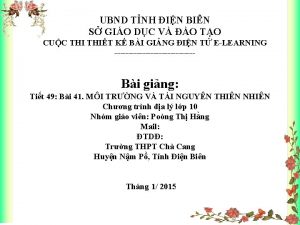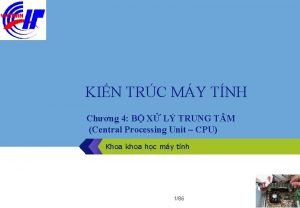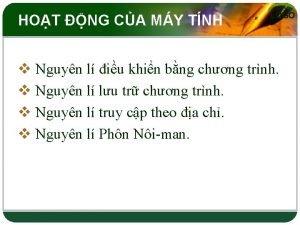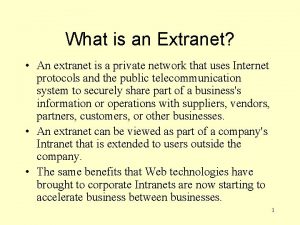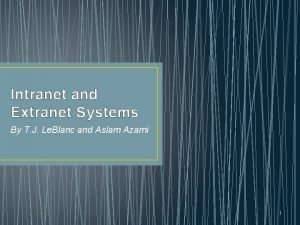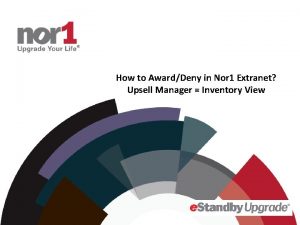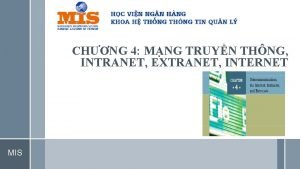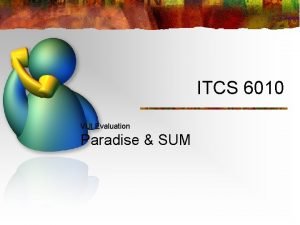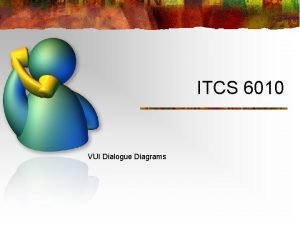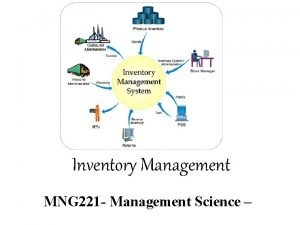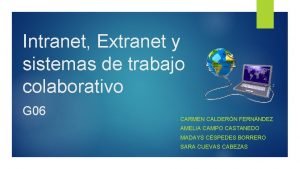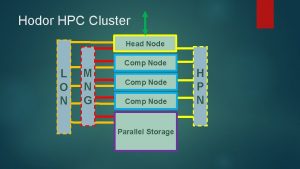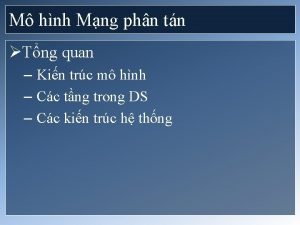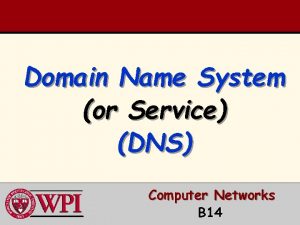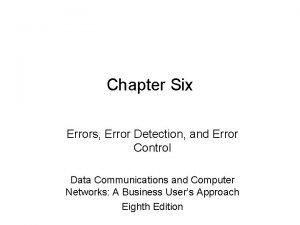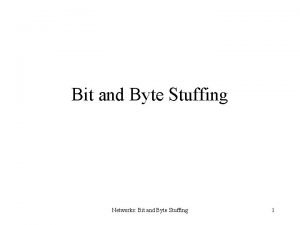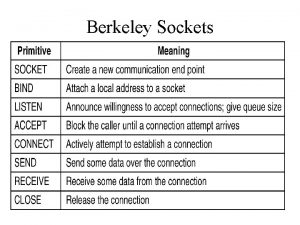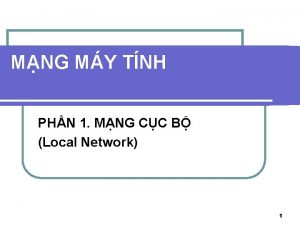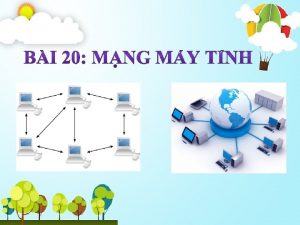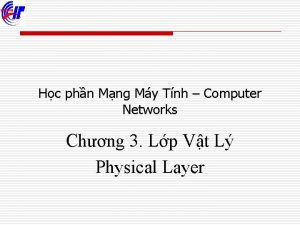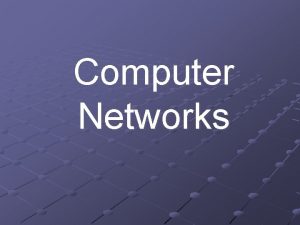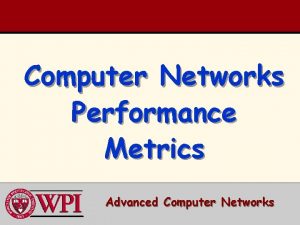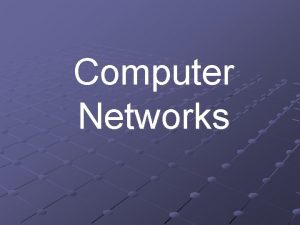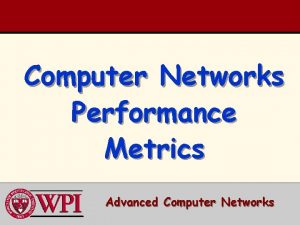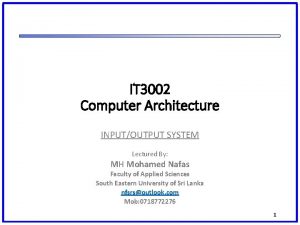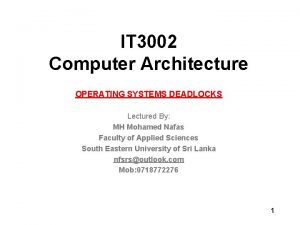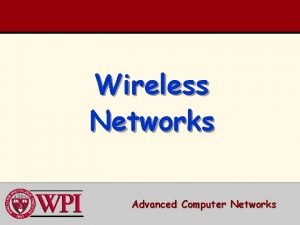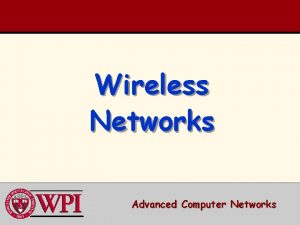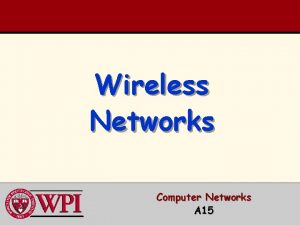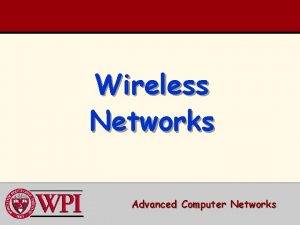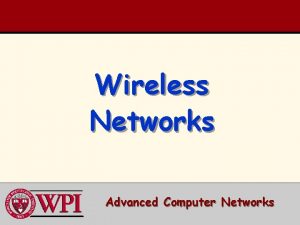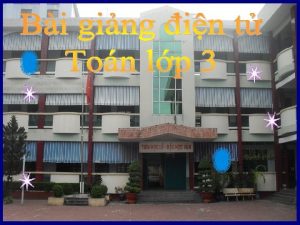Computer Networks 1 Mng My Tnh 1 Lectured


























































- Slides: 58

Computer Networks 1 (Mạng Máy Tính 1) Lectured by: Nguyễn Đức Thái

Course details Number of credits: 4 Study time allocation per week: 3 lecture hours for theory 2 lecture hours for exercises and lab work 8 hours for self-study Website: http: //www. cse. hcmut. edu. vn/~thai/ 2

Course outline (1) Fundamental concepts in the design and implementation of computer networks Protocols, standards and applications Introduction to network programming. 3

Course outline (2) The topics to be covered include: Introduction to network architecture, OSI and the TCP/IP reference models. Network technologies, especially LAN technologies (Ethernet, wireless networks and Bluetooth). Issues related to routing and internetworking, Internet addressing and routing. Internet transport protocols (UDP and TCP) Network-programming interface Application layer protocols and applications such as DNS, E -mail, and WWW. 4

References “Computer Networks”, Andrew S. Tanenbaum, 4 th Edition, Prentice Hall, 2003. “TCP/IP Protocol Suite”, B. A. Forouzan, Mc Graw. Hill, 1 st ed. , 2000. 5

Assessment Assignment 20% Two assignments, 10% each Midterm exam: 20% Final exam: 60% Laboratory work is compulsory No lab work = No assignment mark 6

Lecture 1: Introduction to Computer Networks Reference: Chapter 1 - “Computer Networks”, Andrew S. Tanenbaum, 4 th Edition, Prentice Hall, 2003.

Uses of Computer Networks Business Applications Scientific Applications Home Applications Mobile Users 8

Business Applications of Networks (1) A network with two clients and one server. 9

Business Applications of Networks (2) The client-server model involves requests and replies. 10

Scientific Applications Grid computing infrastructure to support scientific research 11

Home Network Applications (1) Access to remote information Person-to-person communication Interactive entertainment Electronic commerce 12

Home Network Applications (2) In peer-to-peer system there are no fixed clients and servers. 13

Home Network Applications (3) Some forms of e-commerce. 14

Mobile Network Users Combinations of wireless networks and mobile computing. 15

Network Hardware Local Area Networks (LAN) Metropolitan Area Networks (MAN) Wide Area Networks (WAN) Wireless Networks Home Networks Internetworks 16

Local Area Networks Two broadcast networks (a) Bus (b) Ring 17

Metropolitan Area Networks A metropolitan area network based on cable TV. 18

Wide Area Networks (1) Relation between hosts on LANs and the subnet. 19

Wide Area Networks (2) A stream of packets from sender to receiver. 20

Wireless Networks (1) Categories of Wireless Networks System interconnections Wireless LANs Wireless WANs 21

Wireless Networks (2) (a) Bluetooth configuration (b) Wireless LAN 22

Wireless Networks (3) (a) Individual mobile computers (b) A flying LAN 23

Home Network Categories Computers: desktop PC, PDA, shared peripherals Entertainment: TV, DVD, VCR, camera, MP 3 Telecomm: telephone, cell phone, intercom, fax Appliances: microwave, fridge, clock, aircon Telemetry: utility meter, burglar alarm, babycam 24

Network Software Protocol Hierarchies Design Issues for the Layers Connection-Oriented and Connectionless Service Primitives The Relationship of Services to Protocols 25

Network Software Protocol Hierarchies Layers, protocols, and interfaces. 26

Protocol Hierarchies (2) The philosopher-translator-secretary architecture. 27

Protocol Hierarchies (3) Example information flow supporting virtual communication in layer 5. 28

Design Issues for the Layers Addressing Error Control Flow Control Multiplexing Routing 29

Connection-Oriented and Connectionless Services Six different types of service. 30

Service Primitives Five service primitives for implementing a simple connectionoriented service. 31

Service Primitives (2) Packets sent in a simple client-server interaction on a connection-oriented network. 32

Services to Protocols Relationship The relationship between a service and a protocol. 33

Reference Models The OSI Reference Model The TCP/IP Reference Model A Comparison of OSI and TCP/IP A Critique of the OSI Model and Protocols A Critique of the TCP/IP Reference Model 34

OSI Reference Model The OSI reference model. 35

TCP/IP Reference Models (1) The TCP/IP reference model. 36

TCP/IP Reference Model (2) Protocols and networks in the TCP/IP model initially. 37

Comparing OSI and TCP/IP Models Concepts central to the OSI model Services Interfaces Protocols 38

A Critique of the OSI Model and Protocols Why OSI did not take over the world Bad timing Bad technology Bad implementations Bad politics 39

Bad Timing The apocalypse of the two elephants. 40

A Critique of the TCP/IP Reference Model Problems: Service, interface, and protocol not distinguished Not a general model Host-to-network “layer” not really a layer No mention of physical and data link layers Minor protocols deeply entrenched, hard to replace 41

Hybrid Model The hybrid reference model to be used in this book. 42

Example Networks The Internet Connection-Oriented Networks: X. 25, Frame Relay, and ATM Ethernet Wireless LANs: IEEE 802. 11 43

The ARPANET (1) (a) Structure of the telephone system. (b) Baran’s proposed distributed switching system. 44

The ARPANET (2) The original ARPANET design. 45

The ARPANET (3) Growth of the ARPANET (a) December 1969. (b) July 1970. (c) March 1971. (d) April 1972. (e) September 1972. 46

NSFNET The NSFNET backbone in 1988. 47

Internet Usage Traditional applications (1970 – 1990) E-mail News Remote login File transfer 48

Architecture of the Internet Overview of the Internet. 49

ATM Virtual Circuits A virtual circuit. 50

Ethernet Architecture of the original Ethernet. 51

Wireless LANs (1) (a) Wireless networking with a base station. (b) Ad hoc networking. 52

Wireless LANs (2) The range of a single radio may not cover the entire system. 53

Wireless LANs (3) A multicell 802. 11 network. 54

Network Standardization Who’s Who in the Telecommunications World Who’s Who in the International Standards World Who’s Who in the Internet Standards World 55

ITU Main sectors • Radiocommunications • Telecommunications Standardization • Development Classes of Members • National governments • Sector members • Associate members • Regulatory agencies 56

IEEE 802 Standards The 802 working groups. The important ones are marked with *. The ones marked with are hibernating. The one 57 marked with † gave up.

Metric Units The principal metric prefixes. 58
 Packet switching datagram and virtual circuit approach
Packet switching datagram and virtual circuit approach Basestore iptv
Basestore iptv Tnh elearning
Tnh elearning Tnh elearning
Tnh elearning Tnh elearning
Tnh elearning đầu ruồi súng hơi
đầu ruồi súng hơi Tnh elearning
Tnh elearning Tnh elearning
Tnh elearning Elearning tnh
Elearning tnh Logo tnh
Logo tnh Tnh elearning
Tnh elearning Trang tnh
Trang tnh Nguyên lí phôn nôi-man
Nguyên lí phôn nôi-man Tnh elearning edu vn
Tnh elearning edu vn Extranet mng
Extranet mng Extranet system
Extranet system Mngextranet
Mngextranet Ctrip extranet login
Ctrip extranet login Booking extranet logowanie
Booking extranet logowanie Mng php
Mng php Myreading lr
Myreading lr Bnh extranet
Bnh extranet Nnparadise
Nnparadise Mng-6010
Mng-6010 Economic order quantity
Economic order quantity Mng intranet
Mng intranet Cluster head node
Cluster head node Mng intranet
Mng intranet Logo mng
Logo mng Crc in computer networks
Crc in computer networks Crc in computer networks
Crc in computer networks Traffic management in computer networks
Traffic management in computer networks Speed of a computer
Speed of a computer What is optimality principle in computer networks
What is optimality principle in computer networks Snmp osi model
Snmp osi model What is optimality principle in computer networks
What is optimality principle in computer networks Uses of computer networks in business applications
Uses of computer networks in business applications Definition of computer
Definition of computer Dns in computer networks
Dns in computer networks Diffserv vs intserv
Diffserv vs intserv Icmp in computer networks
Icmp in computer networks Web and http in computer networks
Web and http in computer networks Framing in computer network
Framing in computer network Dns in computer networks
Dns in computer networks Data communication assignment questions
Data communication assignment questions Network vs distributed system
Network vs distributed system Algorithms in computer networks
Algorithms in computer networks Error correction in computer networks
Error correction in computer networks Checksum in computer networks with example
Checksum in computer networks with example Internet transport protocol in computer networks
Internet transport protocol in computer networks Error control in computer networks
Error control in computer networks Subnet
Subnet Data link layer switching in computer networks
Data link layer switching in computer networks Layered tasks in computer networks
Layered tasks in computer networks Hdlc byte stuffing
Hdlc byte stuffing Byte stuffing and bit stuffing
Byte stuffing and bit stuffing Byte stuffing
Byte stuffing Berkeley socket primitives
Berkeley socket primitives Arp rarp protocol
Arp rarp protocol






